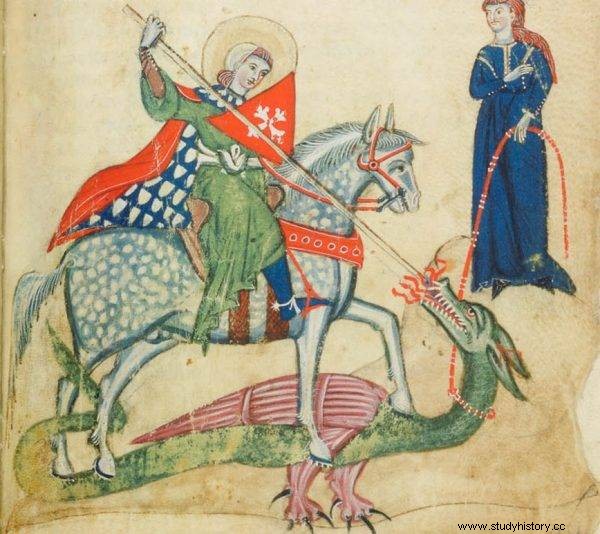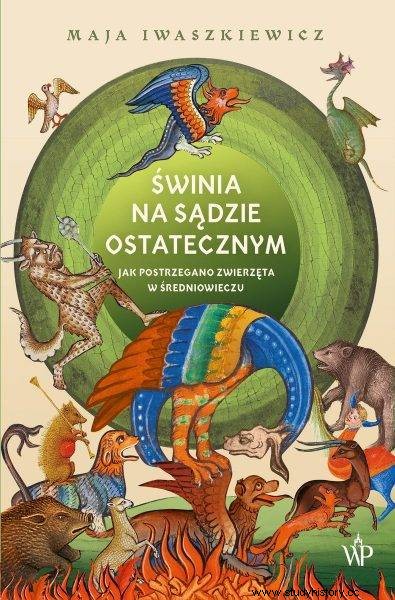The modern image of a dragon known from books or movies suggests that these animals - if they ever existed - would be extraordinary and powerful. Although popular in medieval bestiaries and symbolism, they did not enjoy a good reputation in the Christian world. They were believed to exist, but associated with what was pagan, demonic, and sinister.
The grandson of Seneca the Elder, Lucan, who paid with his life for participation in the conspiracy on the life of Emperor Nero, derived the lineage of dragons from the mythical Medusa and stated that they inhabited the Libyan desert. In the 6th century, Isidore of Seville in Etymologies he wrote of the dragon as "the greatest of all snakes," all covered in scales, living in caves. It did not breathe fire or possess poison - it killed by strangling its victim. He hunted elephants, as we read about in Maja Iwaszkiewicz's book - A pig at the final judgment. How animals were perceived in the Middle Ages :
[…] the dragon is the elephant's greatest opponent and it is because of the fear of him that the elephant gives birth in the water. In medieval symbolism, the dragon ambushes poor elephants, just like the devil to man .
The dragon's greatest strength is its tail, which, in addition to being strong, is so long that it wraps around the huge body of an elephant in many period illustrations. It is not difficult to guess where in the world the dragon came from according to medieval society. Of course, it occurs in India and Ethiopia, which is where the average medieval European is unlikely to come to see if this is true.
Lizard's body, eagle's claws and bat's wings
The 12th-century priest and prior, Hugo de Folieto, considered poisonous dragons as he emphasized that these beasts have "poisonous breath" and that they fly only thanks to "the power of their venom". The monk Fulk of Chartres described their terrifying appearance as follows:
Dragons have long, ugly mouths, sharp teeth and a fiery tongue, have horn-like ears, a long neck and a lizard body. Two legs are like eagles' claws and their wings are like bats.
Before today's image of dragons as great lizards with wings that breathed destructive fire became established in the Western world, they differed by tradition and region. For example, the British wyvern could live on land (then it had clawed legs) or in the sea (then it was depicted with a fish tail). The Germanic or Nordic wurm was much more like a snake, while the Slavic viper, guarding the entrance to Nawia, sometimes took the form of a bird.

Before today's perception of dragons as great lizards with wings that breathed destructive fire became established in the Western world, they differed by tradition and region.
There was also the Wawel dragon, about which Master Wincenty called Kadłubek wrote about the story of Krak (called from Latin Gracch) a story about " a terrible and cruel monster, which some say is called an olophagus "(The name is supposed to derive from Greek and means a monster that swallows the victim whole), and which demanded that the inhabitants of Krakow regularly provide a certain number of cattle.
The ruler ordered his sons to defeat the dragon, which the brothers do, using the trick known to us from the later, 16th-century shoemaker legend with sulfur-filled skins. The younger son then kills the older son and returns with the news that his brother has died in battle. When the truth is revealed, the throne is finally inherited from her father by her daughter, Wanda. In later chroniclers, there is a version about the dragon's death from drinking after eating sulfur.
Was it really believed in the dragon living near Wawel in the times of Długosz and Kadłubek? The doubters could be persuaded by the remains found in the Dragon's Jam. It took many centuries for researchers to explain their origins. " Is this fairy tale a simple fantasy piece, brought from elsewhere, or was it stuck to some natural phenomenon y - asked the geologist Ludwik Zejszner - it is difficult to decide. Maybe the bones of huge antediluvian animals were found in it, and people willing to translate what they did not know attributed them to the dragon. The historian and ethnographer Karol Potkański added:
I don't need to elaborate on the fact that these caves, in which perhaps even […] animal bones were found, became the reason for the location of the dragon story in the original times. [...] The bones of animals, especially those from antediluvians, gave rise to thousands of tales of [...] dragons.
Dragonslayer and birthing patrons
It was emphasized many times in medieval treatises that dragons are a threat to both humans and animals on land and sea. It took an extremely brave, pure-hearted man to face them in direct combat. The most famous, though not the only medieval dragon-slayer is St. Jerzy, about whom we read in Maja Iwaszkiewicz's book:
Beast by The Golden Legend , the lives of saints written by Jacob de Voragine, lived in Libya, near a pond, and devoured whatever she could. The local people gave the dragon two sheep every day, but when these were over, it was ordered that the children had to be returned to him . In the end, it also fell on the king's daughter. Saint George, passing by, saw the princess and promised to save her in the name of Christ, then he rode on the dragon with his sword and cross stretched out in front of him and defeated the beast.

The text was created, among others based on the book by Maja Iwaszkiewicz "Pig on the final judgment", which has just been published by Wydawnictwo Poznańskie.
Interestingly, women were several times dragon slayers - both in the Roman and Greek Catholic traditions. An example would be St. Elizabeth, born in the 5th century in Thrace. When she became an orphan, she distributed the property to the poor and traveled to Constantinople, where her aunt was the prioress of the convent of St. George.
For her zealous faith and asceticism, God rewarded Elizabeth with the power to heal wounds and cast out demons. So when Emperor Leo I gave the monastery the lands inhabited by the terrible dragon, only Elizabeth could deal with the beast. As the abbess of the monastery, which she took over after her aunt's death, faced the dragon barefoot, with the cross in her hands, chasing him into the four winds . When the beast refused to listen to her, Elizabeth made the sign of the cross, spat, grabbed the reptile's head and trampled it.
Another holy dragonslayer, better known in the Western world, was Margaret of Antioch, who lived in the 4th century, a martyr during the persecution of Emperor Diocletian. The legend about her is quoted by Maja Iwaszkiewicz in her book:
One day a man fell in love with her, who decided to marry her at all costs, and ordered her to renounce her Christian faith, which in times of hard patriarchy and persecution Christians was unfortunately common. Małgorzata did not intend to give up her religion and the truths of faith, so the man sentenced her to death. First, she was tortured and then put in prison. There, Margaret began to pray earnestly to God and to ask that she could see her opponent.

When Satan appeared to Margaret in the form of a dragon and tried to devour her, the fearless saint burst from his mouth, killing the beast.
When Satan appeared to Margaret in the form of a dragon and tried to devour her, a fearless saint burst from his mouth, killing the beast. And although she died a martyr's death by beheading, her steadfast faith made medieval women choose her as their patron in the most difficult moment of their lives . Prayers to the saint in childbirth became commonplace in the late Middle Ages - both in the lower classes and among the aristocracy.
Images of Małgorzata Antiocheńska and fragments of parchment with her name were used as protective amulets, placed next to the birthing bed. Thanks to medieval mysteries or the Golden Legend written by Jacob de Voragine she became the patron saint of midwives and women in labor.
Can it be said that the people of the Middle Ages were afraid of dragons? Many probably do, especially those who have seen the terrifying images of beasts lurking in the branches of trees for their prey - both elephants and humans, as described by Pliny the Elder.
To protect themselves from the beasts that fell on their heads and the damage they caused, fires were burned in some regions of Europe, into which bones and various waste were thrown, so that the stinking smoke scared the beasts away. What better educated people waved at these practices, since the treaties said that dragons were exotic animals living in desert countries. So they were left in the deserts of the East to deal with more real threats from local diabolical animals or the ubiquitous witches.
Literature
- M. Iwaszkiewicz, Pig at the final judgment , Poznań Publishing House 2021.
- Plezia, Rocznik Krakowski, The legend of the Wawel dragon , vol. 42/1971.
- Zejszner, Traveling around the Beskids, or describing parts of the Carpathian Mountains between the springs of the Vistula and the San , "Warsaw Library", vol. 3/1848.
- K. J. Czyżewski, Dragons, giants, antediluvian animals. About fossil bones in the Krakow Cathedral , in: Two Faces of the Dragon , vol. II, Kraków 2015, pp. 47-66.
- J. Frazer, The Golden Bough. Studies in Magic and Religion , crowd. H. Krzeczkowski, Vis-a-vis / Etiuda 2012.
- Jakub De Voragine, Golden Legend , Pax Warsaw 1983.
